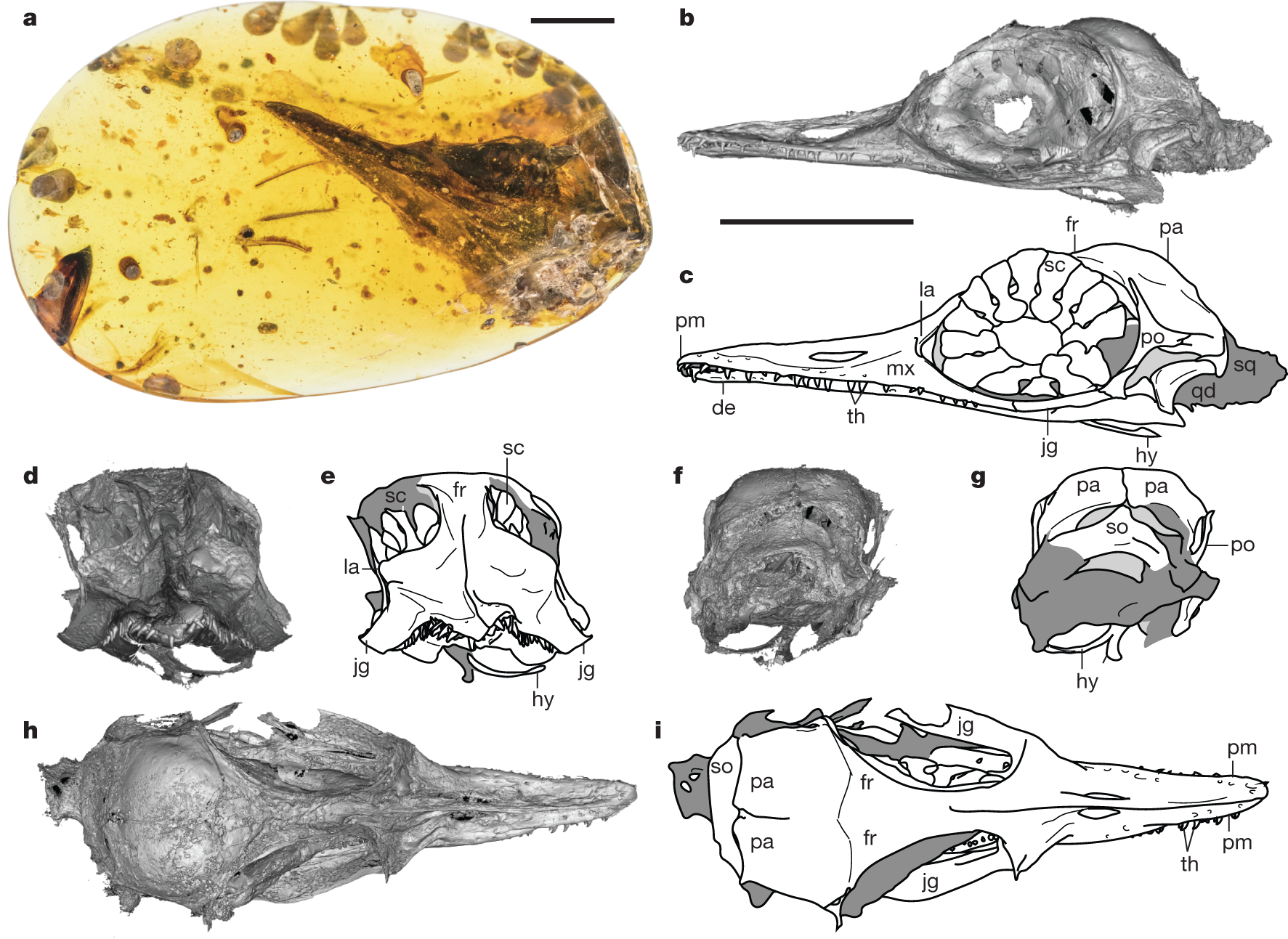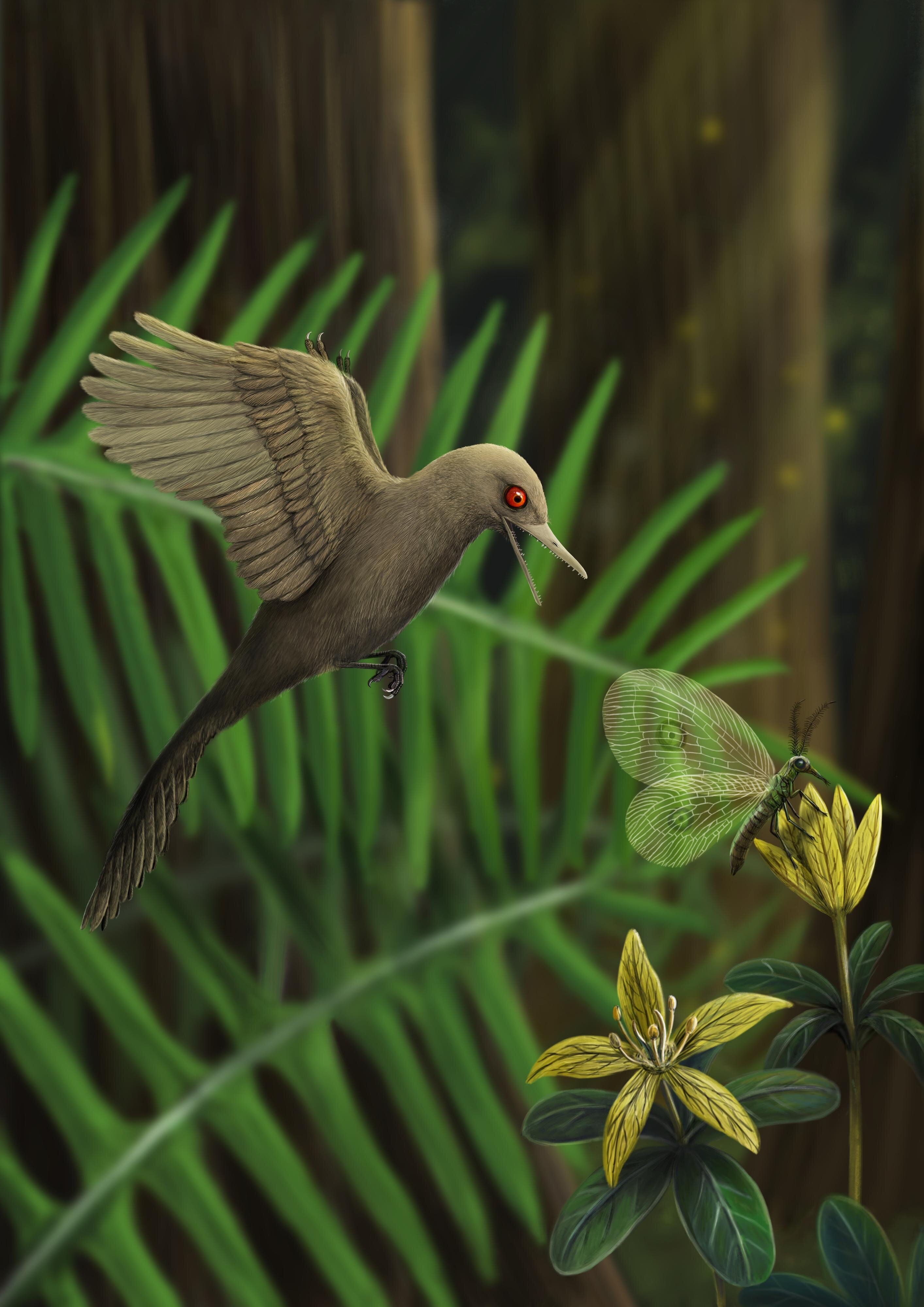Post by Eaglehawk on Mar 13, 2020 7:14:47 GMT
Oculudentavis khaungraae

The head of Oculudentavis khaungraae, the world's tiniest dinosaur, preserved in amber.
Temporal range: Cenomanian, 99 Ma
Scientific classification
Kingdom: Animalia
Phylum: Chordata
Clade: Dinosauria
Clade: Saurischia
Clade: Theropoda
Clade: Avialae
Genus: †Oculudentavis Xing et al., 2020
Type species: †Oculudentavis khaungraae Xing et al., 2020
Oculudentavis is an extinct genus of avialan dinosaurs (birds in the broad sense) with a single known species, Oculudentavis khaungraae. It is known from a complete skull preserved in Burmese amber. The skull was only 1.4 cm (.55 inches) in length, indicating that Oculudentavis was the smallest known Mesozoic dinosaur, close in size to the modern bee hummingbird. It had a slender snout and a bulbous skull roof, as well as a long tooth row of 23 teeth. The orbits were very large and had a thick sclerotic ring formed from unusual spoon-shaped sclerotic ossicles. This indicates that it was likely a diurnal animal, active mostly during the day. The eyes bulge sideways according to an outwardly slanted jugal (cheekbone), indicating that it did not possess binocular vision. It may have had a relatively strong bite and a specialized diet of small invertebrates, based on its sharp teeth, extensively textured mouth skin, tall coronoid process, and robust, inflexible skull.

Oculudentavis had a collection of plesiomorphic ("primitive") and advanced traits compared to other Mesozoic avialans. For example, it retains separate frontal, parietal, postorbital, and squamosal bones, which are fused together or lost in modern birds. The extensive tooth row is also similar to non-avialan theropods. On the other hand, the antorbital fenestra is confluent with the orbit, while the bones of the snout are elongated and fused. These features are more common among modern birds. Some traits, such as the acrodont or pleurodont tooth implantation and spoon-shaped sclerotic bones are unprecedented for dinosaurs as a whole and instead are common among modern lizards. Specializations caused by the small size of Oculudentavis lead to difficulty in making precise conclusions on its classification. A phylogenetic analysis supports a basal placement for Oculudentavis within Avialae, only slightly closer to modern birds than Archaeopteryx. This suggests that a ~50 million year ghost lineage exists between the Late Jurassic and the middle of the Cretaceous. A small amount of most parsimonious trees instead suggest that it is an enantiornithean, like other "birds" preserved in Burmese amber.
Discovery of smallest known mesozoic dinosaur reveals new species in bird evolution
by Scripps College

An artistic rendering of Oculudentavis imagining what it looked like preying on an insect by HAN Zhixin.
The discovery of a small, bird-like skull, described in an article published in Nature, reveals a new species, Oculudentavis khaungraae, that could represent the smallest known Mesozoic dinosaur in the fossil record.
While working on fossils from in northern Myanmar, Lars Schmitz, associate professor of biology at the W.M. Keck Science Department, and a team of international researchers discovered a seemingly mature skull specimen preserved in Burmese amber. The specimen's size is on par with that of the bee hummingbird, the smallest living bird.
"Amber preservation of vertebrates is rare, and this provides us a window into the world of dinosaurs at the lowest end of the body-size spectrum," Schmitz said. "Its unique anatomical features point to one of the smallest and most ancient birds ever found."
The team studied the specimen's distinct features with high-resolution synchrotron scans to determine how the skull of the Oculudentavis khaungraae differs from those of other bird-like dinosaur specimens of the era. They found that the shape and size of the eye bones suggested a diurnal lifestyle, but also revealed surprising similarities to the eyes of modern lizards. The skull also shows a unique pattern of fusion between different bone elements, as well as the presence of teeth. The researchers concluded that the specimen's tiny size and unusual form suggests a never-before-seen combination of features.
The discovery represents a specimen previously missing from the fossil record and provides new implications for understanding the evolution of birds, demonstrating the extreme miniaturization of avian body sizes early in the evolutionary process. The specimen's preservation also highlights amber deposits' potential to reveal the lowest limits of vertebrate body size.
"No other group of living birds features species with similarly small crania in adults," Schmitz said. "This discovery shows us that we have only a small glimpse of what tiny vertebrates looked like in the age of the dinosaurs."
phys.org/news/2020-03-discovery-smallest-mesozoic-dinosaur-reveals.html
Journal Reference:
Xing, L., O’Connor, J.K., Schmitz, L. et al. Hummingbird-sized dinosaur from the Cretaceous period of Myanmar. Nature 579, 245–249 (2020). doi.org/10.1038/s41586-020-2068-4
Abstract
Skeletal inclusions in approximately 99-million-year-old amber from northern Myanmar provide unprecedented insights into the soft tissue and skeletal anatomy of minute fauna, which are not typically preserved in other depositional environments. Among a diversity of vertebrates, seven specimens that preserve the skeletal remains of enantiornithine birds have previously been described, all of which (including at least one seemingly mature specimen) are smaller than specimens recovered from lithic materials. Here we describe an exceptionally well-preserved and diminutive bird-like skull that documents a new species, which we name Oculudentavis khaungraae gen. et sp. nov. The find appears to represent the smallest known dinosaur of the Mesozoic era, rivalling the bee hummingbird (Mellisuga helenae)—the smallest living bird—in size. The O. khaungraae specimen preserves features that hint at miniaturization constraints, including a unique pattern of cranial fusion and an autapomorphic ocular morphology that resembles the eyes of lizards. The conically arranged scleral ossicles define a small pupil, indicative of diurnal activity. Miniaturization most commonly arises in isolated environments, and the diminutive size of Oculudentavis is therefore consistent with previous suggestions that this amber formed on an island within the Trans-Tethyan arc. The size and morphology of this species suggest a previously unknown bauplan, and a previously undetected ecology. This discovery highlights the potential of amber deposits to reveal the lowest limits of vertebrate body size.
www.nature.com/articles/s41586-020-2068-4

The head of Oculudentavis khaungraae, the world's tiniest dinosaur, preserved in amber.
Temporal range: Cenomanian, 99 Ma
Scientific classification
Kingdom: Animalia
Phylum: Chordata
Clade: Dinosauria
Clade: Saurischia
Clade: Theropoda
Clade: Avialae
Genus: †Oculudentavis Xing et al., 2020
Type species: †Oculudentavis khaungraae Xing et al., 2020
Oculudentavis is an extinct genus of avialan dinosaurs (birds in the broad sense) with a single known species, Oculudentavis khaungraae. It is known from a complete skull preserved in Burmese amber. The skull was only 1.4 cm (.55 inches) in length, indicating that Oculudentavis was the smallest known Mesozoic dinosaur, close in size to the modern bee hummingbird. It had a slender snout and a bulbous skull roof, as well as a long tooth row of 23 teeth. The orbits were very large and had a thick sclerotic ring formed from unusual spoon-shaped sclerotic ossicles. This indicates that it was likely a diurnal animal, active mostly during the day. The eyes bulge sideways according to an outwardly slanted jugal (cheekbone), indicating that it did not possess binocular vision. It may have had a relatively strong bite and a specialized diet of small invertebrates, based on its sharp teeth, extensively textured mouth skin, tall coronoid process, and robust, inflexible skull.

Oculudentavis had a collection of plesiomorphic ("primitive") and advanced traits compared to other Mesozoic avialans. For example, it retains separate frontal, parietal, postorbital, and squamosal bones, which are fused together or lost in modern birds. The extensive tooth row is also similar to non-avialan theropods. On the other hand, the antorbital fenestra is confluent with the orbit, while the bones of the snout are elongated and fused. These features are more common among modern birds. Some traits, such as the acrodont or pleurodont tooth implantation and spoon-shaped sclerotic bones are unprecedented for dinosaurs as a whole and instead are common among modern lizards. Specializations caused by the small size of Oculudentavis lead to difficulty in making precise conclusions on its classification. A phylogenetic analysis supports a basal placement for Oculudentavis within Avialae, only slightly closer to modern birds than Archaeopteryx. This suggests that a ~50 million year ghost lineage exists between the Late Jurassic and the middle of the Cretaceous. A small amount of most parsimonious trees instead suggest that it is an enantiornithean, like other "birds" preserved in Burmese amber.
Discovery of smallest known mesozoic dinosaur reveals new species in bird evolution
by Scripps College

An artistic rendering of Oculudentavis imagining what it looked like preying on an insect by HAN Zhixin.
The discovery of a small, bird-like skull, described in an article published in Nature, reveals a new species, Oculudentavis khaungraae, that could represent the smallest known Mesozoic dinosaur in the fossil record.
While working on fossils from in northern Myanmar, Lars Schmitz, associate professor of biology at the W.M. Keck Science Department, and a team of international researchers discovered a seemingly mature skull specimen preserved in Burmese amber. The specimen's size is on par with that of the bee hummingbird, the smallest living bird.
"Amber preservation of vertebrates is rare, and this provides us a window into the world of dinosaurs at the lowest end of the body-size spectrum," Schmitz said. "Its unique anatomical features point to one of the smallest and most ancient birds ever found."
The team studied the specimen's distinct features with high-resolution synchrotron scans to determine how the skull of the Oculudentavis khaungraae differs from those of other bird-like dinosaur specimens of the era. They found that the shape and size of the eye bones suggested a diurnal lifestyle, but also revealed surprising similarities to the eyes of modern lizards. The skull also shows a unique pattern of fusion between different bone elements, as well as the presence of teeth. The researchers concluded that the specimen's tiny size and unusual form suggests a never-before-seen combination of features.
The discovery represents a specimen previously missing from the fossil record and provides new implications for understanding the evolution of birds, demonstrating the extreme miniaturization of avian body sizes early in the evolutionary process. The specimen's preservation also highlights amber deposits' potential to reveal the lowest limits of vertebrate body size.
"No other group of living birds features species with similarly small crania in adults," Schmitz said. "This discovery shows us that we have only a small glimpse of what tiny vertebrates looked like in the age of the dinosaurs."
phys.org/news/2020-03-discovery-smallest-mesozoic-dinosaur-reveals.html
Journal Reference:
Xing, L., O’Connor, J.K., Schmitz, L. et al. Hummingbird-sized dinosaur from the Cretaceous period of Myanmar. Nature 579, 245–249 (2020). doi.org/10.1038/s41586-020-2068-4
Abstract
Skeletal inclusions in approximately 99-million-year-old amber from northern Myanmar provide unprecedented insights into the soft tissue and skeletal anatomy of minute fauna, which are not typically preserved in other depositional environments. Among a diversity of vertebrates, seven specimens that preserve the skeletal remains of enantiornithine birds have previously been described, all of which (including at least one seemingly mature specimen) are smaller than specimens recovered from lithic materials. Here we describe an exceptionally well-preserved and diminutive bird-like skull that documents a new species, which we name Oculudentavis khaungraae gen. et sp. nov. The find appears to represent the smallest known dinosaur of the Mesozoic era, rivalling the bee hummingbird (Mellisuga helenae)—the smallest living bird—in size. The O. khaungraae specimen preserves features that hint at miniaturization constraints, including a unique pattern of cranial fusion and an autapomorphic ocular morphology that resembles the eyes of lizards. The conically arranged scleral ossicles define a small pupil, indicative of diurnal activity. Miniaturization most commonly arises in isolated environments, and the diminutive size of Oculudentavis is therefore consistent with previous suggestions that this amber formed on an island within the Trans-Tethyan arc. The size and morphology of this species suggest a previously unknown bauplan, and a previously undetected ecology. This discovery highlights the potential of amber deposits to reveal the lowest limits of vertebrate body size.
www.nature.com/articles/s41586-020-2068-4


